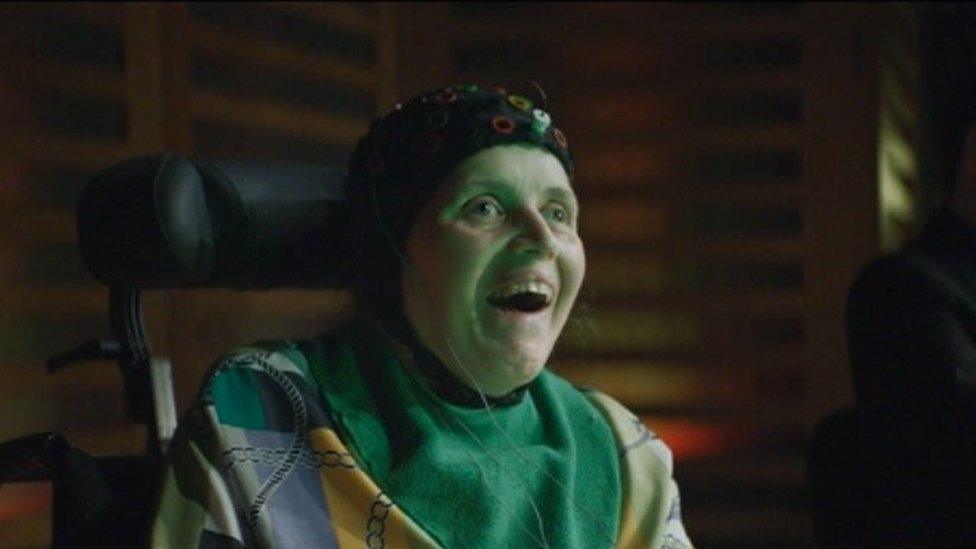Violinist uses brain waves to play 29 years after accident
- Published

Rosemary Johnson using the electrode-covered cap to select music using her eyes
A former Welsh National Opera violinist who was paralysed in a car crash 30 years ago has performed music again using brain wave technology.
Rosemary Johnson is unable to move or speak but using sensors attached to her head can select notes from a screen for another violinist to play.
Her former colleague Alison Balfour-Paul, from Cardiff, brought the music to life along with an orchestra.
The resulting performance has been made into a short film, external.
The technology was developed in a joint project between Plymouth University and the Royal Hospital for Neuro-disability in London, where Ms Johnson lives.
Brain Computer Music Interfacing technology works with a user wearing a cap with electrodes which can read electric information from their brain.
The user can then select music from a screen with their eye movements. The music chosen is displayed on a screen in front of a partner musician who plays it in real time.
The university teamed up with the Royal Hospital and composer Prof Eduardo Miranda for the project involving Ms Johnson.

Alison Balfour-Paul still works as a freelance violinist
A promising classical musician, at age 22 Ms Johnson was fourth violin at the Welsh National Opera (WNO) orchestra in 1988 when she was in a car crash on her way to a gig in north Wales.
She had only been with the WNO for nine months when the accident happened.
Ms Balfour-Paul, who lives in Cardiff, was approached six weeks ago by a mutual friend who had stayed in touch with Ms Johnson, after no-one could be found to play with her.
She said: "I accepted because I was a colleague of Rosie 29 years ago. She was a lovely player with everything going for her. She was caught up in this terrible accident and it left her terribly brain-damaged.
"She was a very open, kind of happy, bubbly person, no great pride in what she was doing - she was just a natural."
The music which the pair play together has been composed by Prof Miranda in advance. Ms Johnson is given a choice of four different notes and selects the one she wants on the screen in front of her, which then displays on Ms Balfour-Paul's screen and she plays it in real time.
'We could feel the joy'
Ms Balfour-Paul remained at the WNO after Ms Johnson's accident and now works as a freelance musician.
She said of the technology: "I hope it goes somewhere. I hope it can help more people - that's the whole point of such technology."
Prof Miranda said of the project: "The first time we tried with Rosemary we were in tears. We could feel the joy coming from her at being able to make music.
"When I met Rosie for the first time, something clicked. It is very interesting working with her. Because she is a classically trained musician, I don't have to ask her too many questions, through the technology we are almost instantly working in a realm of musical communication.
"Working with her is helping us to develop and shape this technology. It's a wonderful blend of science and creativity."
- Published19 April 2017
- Published29 March 2017
